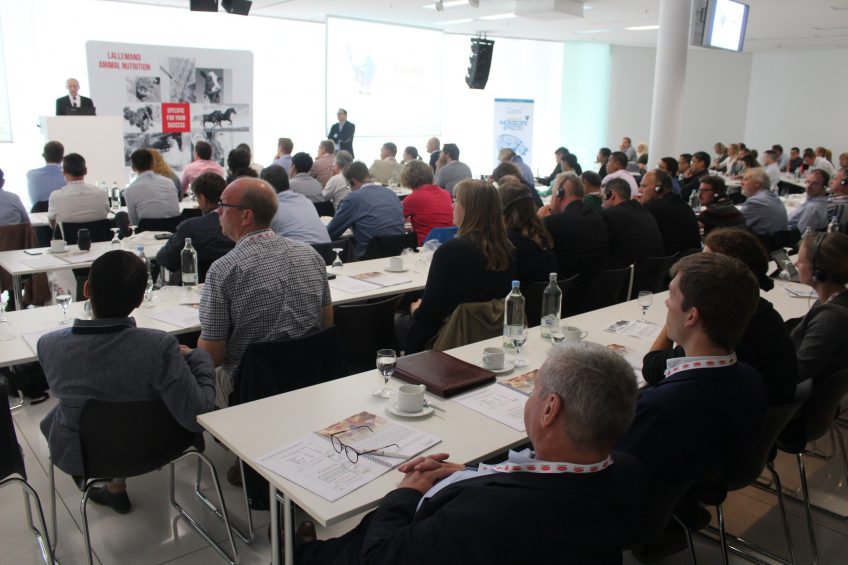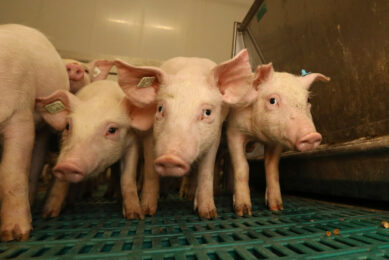A potential role for yeast to reduce mycotoxin effects

A live yeast may hold promises with regard to reducing the effects of mycotoxins. That was one of the major take-home messages at a recent technical meeting organised by Lallemand Animal Nutrition, held June 19, 2018 in Münster, Germany.
Dr Imourana Alassane-Kpembi, a researcher from Lallemand working at the French National Institute for Animal Health (INRA), discussed the effects of mycotoxins on swine health at the event – and closed off his presentation with mentioning various trials done by his team to investigate whether applying Lallemand’s Saccharomyces boulardii yeast (Levucell SB) would actually have an effect on the prevention of the intestinal and immune damage caused by the presence of mycotoxins in the feed.
Protective effect of the probiotic
Without pretending the effect would be a silver bullet for all mycotoxin problems, the research team did conclude that there is a ‘protective’ effect of the probiotic – especially on sub-clinical problems caused by mycotoxins. Dr Alassane-Kpembi stated that the yeast product “can mitigate the effect of fumonisins B1 on intestinal tissue and internal organs.” Comparable effects were also observed with the mycotoxin desoxynivalenol (DON). In addition, the team found a positive effect on vaccination response in post-weaned piglets. They were immunocompromised by the exposition to a high dose of fumonisin B1.
Dr Alassane-Kpembi was one of the 7 speakers in total that addressed the audience at the annual International Levucell SB Technical Meeting, that was held for the 10th time, and attracted 160 swine experts from 20 countries worldwide.
Read more about the 9th Levucell SB Technical Meeting, held in Ho Chi Minh City in Vietnam in 2017
Different ways of looking at ‘energy’ in swine diets
The meeting was kicked off by the well-known French researcher Jean Noblet, who used to work for INRA and nowadays is a consultant in monogastric nutrition. In an insightful presentation, he reminded his audience of the main ways to look at energy in swine feed – and what are the differences between gross energy (GE), digestible energy (DE), metabolisable energy (ME) and net energy (NE). He advised the use of the latter for more accuracy and cost saving reasons, taking into account the differences between growing pigs and reproductive sows.
Demonstrating mechanisms behind yeast
Yannig Le Treut, general manager at Lallemand Animal Nutrition, then discussed the ongoing quest to demonstrate the mechanisms behind the effect of Levucell SB on sows to produce healthy litters of pigs. According to him, S. boulardii is oxygen scavenging in the caecum and the colon, creating a better condition for anaerobic bacteria, leading to better fermentation rates and more energy taken from the same diet.
That was further confirmed in a trial done by INRA with finisher pigs put into metabolic chambers. Dr Le Treut also highlighted the improvement on the energy retention.
He reminded the audience of known benefits of the application of live yeast to sows, e.g. farrowing quality, prevention of neonatal diarrhoea, stimulation of feed intake, even during heat stress conditions.
Alleviating heat stress problems
Prof Bruno Silva from the Universidade Federal de Minas Gerais, Brazil, zoomed in on the effects of heat stress on lactating sows. Creating the right environment can help alleviating the problems of heat stress, he said, and so does the supplementation of live yeast to sow diets. In this respect he speaks of the ‘thermal effect of feed’, i.e. how much effort (energy/heat) does it cost a sow to digest certain feed ingredients? Taking this into account, smarter feed formulations can be chosen for potential heat stress situations.
Recently Pig Progress interviewed Prof Bruno Silva about his ideas on heat stress in sows in tropical conditions
Caroline Achard, research scientist at Lallemand Animal Nutrition then shifted the emphasis to the world of metagenomics and presented the progress in her analysis of the characterisation of the porcine microbiota. Understanding the composition of the microbiome is essential as that allows the identification of the effects of Levucell SB, she said. Eventually that again should lead to determining the ‘optimal microbial profile for improved feed efficiency’, she said.
Apart from confirming old discoveries with these new techniques, Dr Achard presented internal results showing how the microbial differentiation done in sows with the application of the live yeast during lactation is then passed to the piglets, which show a different microbial profile 20 days after weaning.

A model of a post-weaned gut
In a theoretical presentation, Mathieu Castex, R&D director at Lallemand Animal Nutrition, discussed about post-weaning disbyosis and introduced the PigutIVM – an in vitro model of a post-weaned piglet gut, in which many trials can be done without having to cull any animals. This way also the effect of probiotics in a piglet gut can be measured. The method, he demonstrated, provides many opportunities for the future.
Last but not least, Raúl Herrer Barcos took the floor, a Spanish pig vet working for the French cooperative La Cavac. In a practical presentation he explained what kinds of strategies his company uses to produce without antibiotics as much as possible. Apart from clear biosecurity rules, good attention for water, animal welfare, the reduction of piglet processing just after birth, he also touched on nutritional programmes for piglets, which includes live yeast probiotics.












